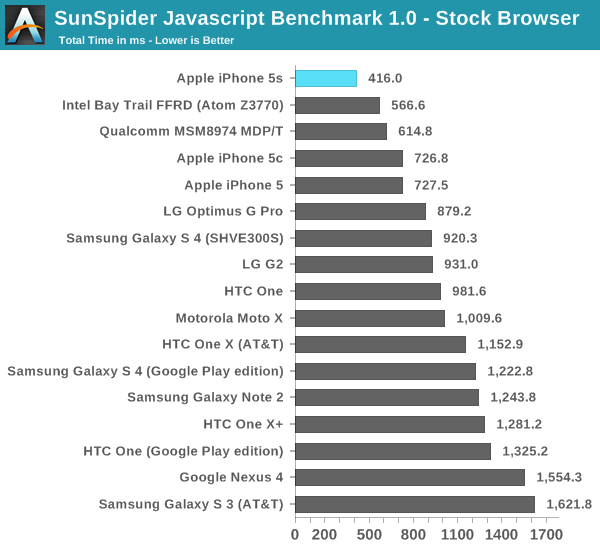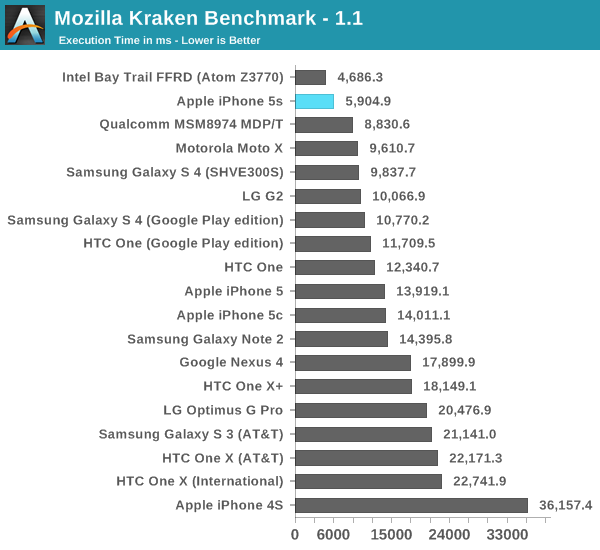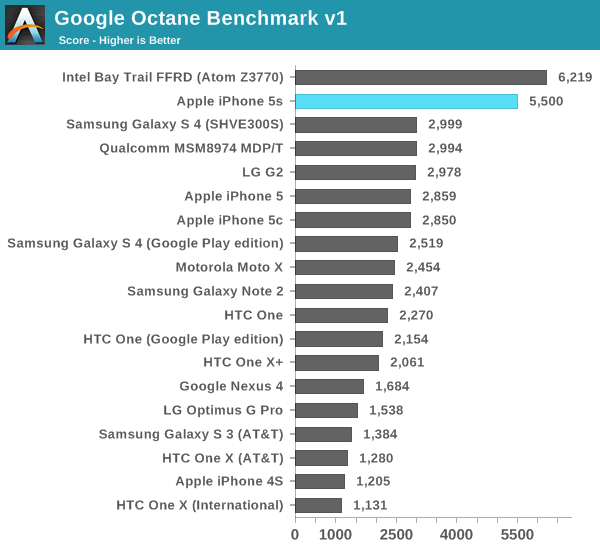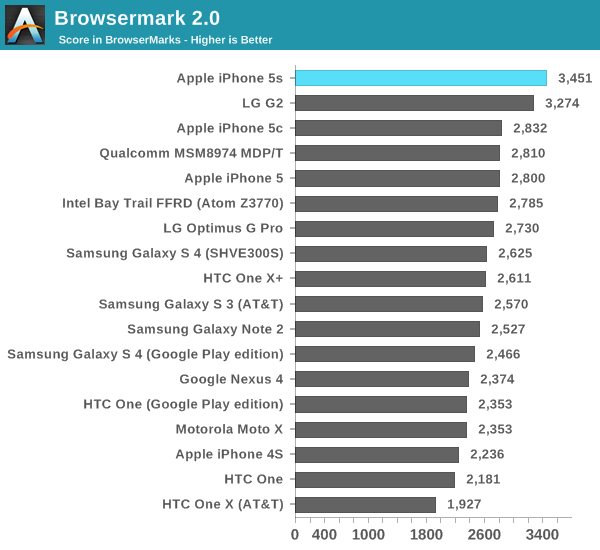The iPhone 5s Review
by Anand Lal Shimpi on September 17, 2013 9:01 PM EST- Posted in
- Smartphones
- Apple
- Mobile
- iPhone
- iPhone 5S
CPU Performance
For our cross-platform CPU performance tests we turn to the usual collection of Javascript and HTML5 based browser tests. Most of our comparison targets here are smartphones with two exceptions: Intel's Bay Trail FFRD and Qualcomm's MSM8974 Snapdragon 800 MDP/T. Both of those platforms are test tablets, leveraging higher TDP silicon in a tablet form factor. The gap between the TDP of Apple's A7 and those two SoCs isn't huge, but there is a gap. I only include those platforms as a reference point. As you're about to see, the work that Apple has put into the A7 makes the iPhone 5s performance competitive with both. In many cases the A7 delivers better performance than one or both of them. A truly competitive A7 here also gives an early indication of the baseline to expect from the next-generation iPad.
We start with SunSpider's latest iteration, measuring the performance of the browser's js engine as well as the underlying hardware. It's possible to get good performance gains by exploiting advantages in both hardware and software here. As of late SunSpider has turned into a bit of a serious optimization target for all browser and hardware vendors, but it can be a good measure of an improving memory subsystem assuming the software doesn't get in the way of the hardware.

Bay Trail's performance crown lasted all of a week, and even less than that if you count when we actually ran this benchmark. The dual-core A7 is now the fastest SoC we've tested under SunSpider, even outpacing Qualcomm's Snapdragon 800 and ARM's Cortex A15. Apple doesn't quite hit the 2x increase in CPU performance here, but it's very close at a 75% perf increase compared to the iPhone 5. Update: Intel responded with a Bay Trail run under IE11, which comes in at 329.6 ms.
Next up is Kraken, a heavier js benchmark designed to stress more forward looking algorithms. Once again we run the risk of the benchmark becoming an optimization target, but in the case of Kraken I haven't seen too much attention paid to it. I hope it continues to fly under the radar as I've liked it as a benchmark thus far.

The A7 falls second only to Intel's Atom Z3770. Although I haven't yet published these results, the 5s performs very similarly to an Atom Z3740 - a more modestly clocked Bay Trail SKU from Intel. Given the relatively low CPU frequency I'm not at all surprised that the A7 can't compete with the fastest Bay Trail but instead is better matched for a middle of the road SKU. Either way, A7's performance here is downright amazing. Once again there's a performance advantage over Snapdragon 800 and Cortex A15, both running at much higher peak frequencies (and likely higher power levels too, although that's speculation until we can tear down an S800 platform and a 5s to compare).
Compared to the iPhone 5, the 5s shows up at over 2.3x the speed of last year's flagship.
Next up is Google's Octane benchmark, yet another js test but this time really used as a design target for Google's own V8 js engine. Devices that can run Chrome tend to do the best here, potentially putting the 5s at a disadvantage.

Bay Trail takes the lead here once again, but again I expect the Z3740 to be a closer match for the A7 in the 5s at least (it remains to be seen how high the iPad 5 version of Cyclone will be clocked). The performance advantage over the iPhone 5 is a staggering 92%, and obviously there are big gains over all of the competing ARM based CPU architectures. Apple is benefitting slightly from Mobile Safari being a 64-bit binary, however I don't know if it's actually getting any benefit other than access to increased register space.
Our final browser test is arguably the most interesting. Rather than focusing on js code snippets, Browsermark 2.0 attempts to be a more holistic browser benchmark. The result is much less peaky performance and a better view at the sort of moderate gains you'd see in actual usage.

There's a fair amount of clustering around 2500 with very little differentiation between a lot of the devices. The unique standouts are the Snapdragon 800 based G2 from LG, and of course the iPhone 5s. Here we see the most modest example of the A7's performance superiority at roughly 25% better than the iPhone 5. Not to understate the performance of the iPhone 5s, but depending on workload you'll see a wide range of performance improvements.










464 Comments
View All Comments
melgross - Wednesday, September 18, 2013 - link
Considering the differences in the multitasking implementations, 1GB for iOS is closer to 2GB for Android. It's not as much of an issue.DarkXale - Wednesday, September 18, 2013 - link
Considering iOS's tendency to reset everything that isn't in the foreground there is plenty of motivation for increasing RAM. As is, I cannot depend on iOS to remember what I was doing in an app as soon as I switch out of it. Even if its for just 2 seconds.On the iPad 4 you basically can't have multiple tabs open in Safari. If you browse or scroll, write anything, or trigger any javascript in them - it'll be undone once you move to another tab. That is, quite frankly, awful user experience. And thats purely down to RAM shortage.
Dug - Wednesday, September 18, 2013 - link
Try a different browser. Others don't do what you are explaining so I don't think it's a ram shortage.jeffkibuule - Wednesday, September 18, 2013 - link
If I remember correctly, you need more RAM when running a virtual machine (then again, Windows Phone has a CLR and most of their phones have 1GB or less...).I honestly think it's because Android apps are allowed to run in the background without a care in the world, whereas on iOS, you must be performing a specific task the API allows to get that time. And if you are using too much memory, you get axed.
steven75 - Thursday, September 19, 2013 - link
True on iOS 6, but no longer true on iOS 7.danbob999 - Wednesday, September 18, 2013 - link
I would have prefered a 32 bit CPU with more RAM.KPOM - Tuesday, September 17, 2013 - link
Nice thorough review as always, Anand.juicytuna - Tuesday, September 17, 2013 - link
That CPU is amazing. Higher IPC than A15 and without spending die area on implementing a complicated big.LITTLE scheme to keep power down. Have ARM and Qualcomm engineers been sleeping all this time? Their efforts look to be hopelessly outclassed by Apple. This is a big a feat as when intel dropped Conroe on the world.ddriver - Wednesday, September 18, 2013 - link
No they haven't been sleeping, they just know when enough is enough. What kind of applications are you running on a mobile phone? 3D MAX? MATLAB? ANSYS? Or are you just using it to jerk your vanity around facebook and take duckface photos in front of the bathroom mirror? I know most people are :) Surely, extra performance never hurts, and will likely improve battery life a bit, but knowing how much is "enough" never hurts on its own.ARM v8 transition is scheduled for all high-end products, apple just did it before it was optimal to impress its fanatical devotees and reinforce their blind belief in the brand. Just like it used exclusive deals with hardware vendors to bring new tech a little earlier than other manufacturers to give itself an "edge".
The funny part is that if performance intensive applications were even available for mobile phones, the 5S will run into a brickwall with its single gigabyte of ram, because real-world workloads are nothing like those limited footprint benchmarks used in this review. I suspect the note 3 will actually score better in a heavy real-world application despite its slower CPU, because the moment the 5s runs out of memory swapping begins, and that speedy CPU will be brought to its knees because of the terrible storage bandwidth. Luckily, it is very unlikely to see any such applications for mobile phones, at least in the general public, in-house custom implementations are another matter.
dugbug - Wednesday, September 18, 2013 - link
There is a review above that describes the benefits empirically. You may want to read it.Also, ARM was surely not asleep at the wheel, they created the outstanding V8 architecture and I am sure were very in the loop with apple. Qualcomm on the other hand are in a quandary as they need to wait for an OS to be ready for this. Windows phone perhaps?